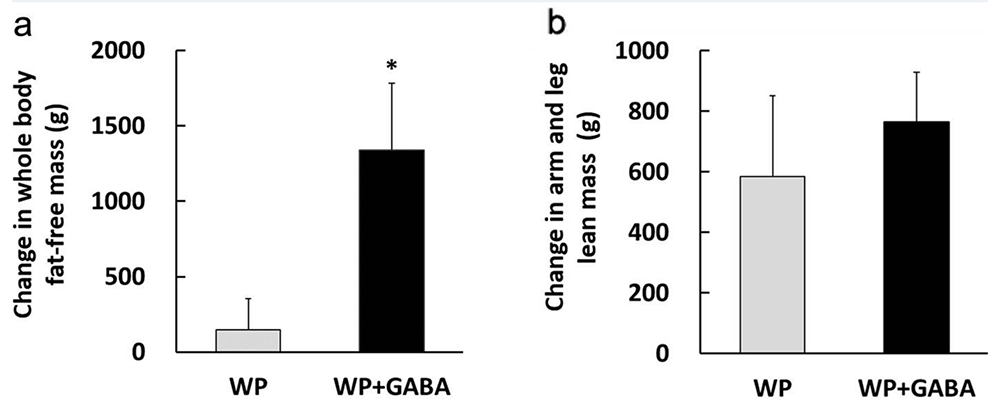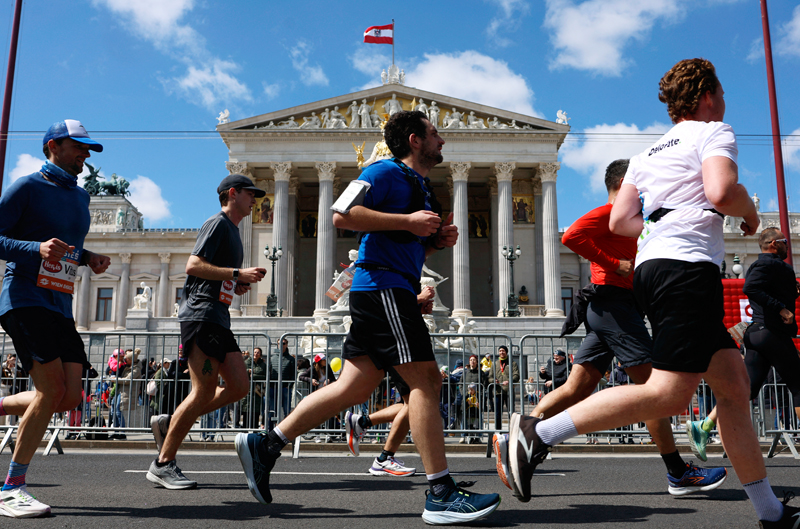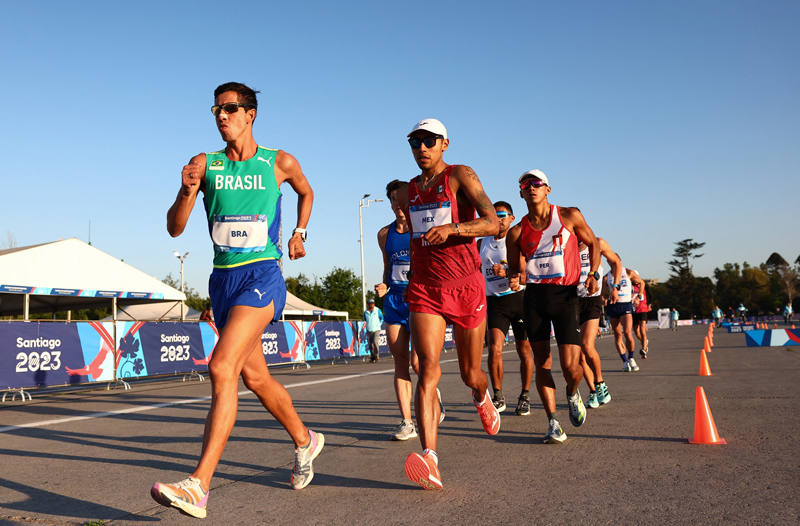GABA: a calmer route to a leaner body?

GABA has long been popular as an ‘anti-anxiety’ supplement. But some research suggests that it could act as a natural stimulator of growth hormone release, enhancing fat loss, and muscle and strength gains. PP looks at the evidence
Back in the 90s, the use of creatine as strength-building supplement produced a revolution in the world of sports nutrition. That’s because unlike most other supplements out there, it actually did what it claimed on the tin! Since then, a number of other strength supplements, all promising great things, have appeared on the sports supplement scene, but only a very few such as whey protein have been proven widely effective in the context of athletic performance. This history of (mainly) false dawns should be borne in mind whenever a discussion of a ‘new’ sports supplement arises; by the same token however, it doesn’t mean that we shouldn’t seriously consider other, lesser-known nutrients if enough god-quality evidence arises.GABA – a lesser known nutrient
One fairly anonymous nutrient that could be worth considering is gamma amino butyric acid (more commonly known as GABA). GABA is a naturally occurring amino acid present in small amounts in the body. Although it’s not present in muscle tissue or in food, GABA can be synthesized in the body from the amino acid L-glutamine and is also found in the central nervous system, pancreatic islet cells and kidney.The really interesting thing about GABA however is its role in the regulation of brain chemistry; GABA is the chief ‘inhibitory’ neurotransmitter in the brain, tending to decrease or ‘dampen’ the brains electrochemical activity and therefore excitability of nerve cells(1). This explains why taking supplemental GABA can produce anti-anxiety and anti-convulsant effects(2), and why much research into medication to combat anxiety and convulsions has focused around slowing down the breakdown of GABA in the breakdown to boost its concentration in nerve cells. All well and good, but what if anything could GABA offer to athletes seeking to maximize performance?
The role of growth hormone
Previous research has shown that GABA supplementation seems to directly stimulate growth hormone secretion in the brain via centrally mediated mechanisms(3,4). Growth hormone (GH) is a large protein molecule that is synthesised, stored, and secreted by specialised cells within anterior pituitary gland in the brain (see box 1). In the body, GH has a number of biological functions, but of particular relevance to athletic performance is the fact that it increases protein synthesis and promotes fat burning(5), increases calcium retention and therefore strengthens and increases bone mineralisation, and it also stimulates the immune system.Box1: GH in the body – irGH and ifGH
Growth hormone (GH) exists in several forms in the body, only some of which are biologically active. To produce its biological effects, GH must bind to GH receptors on cell surfaces in a kind of ‘lock and key’ reaction.There are two specific regions of the GH molecule that can bind to these receptors and thus switch on the chain of biological reactions that follow; if a GH molecule contains both of these regions, it is assumed to be biologically active. This ‘active’ form of GH is sometimes referred to as ‘immunofunctional GH’ or ifGH. By contrast, ‘immunoreactive GH’ refers to a measure of total GH present (ie all of the forms of GH, both biologically active and inactive).
Although rises and falls in irGH levels are normally mirrored by similar changes in ifGH levels, the ideal measurement of GH levels in research studies is ifGH, because this is guaranteed to be the fraction of GH that is active in the body.
In adults, GH is not secreted steadily, but instead in discreet bursts resulting in around five large pulses or peaks of GH release each day. These peaks last from about 10-30 minutes and the most predictable of these peaks occurs roughly an hour after the onset of sleep(6). However, another extremely powerful GH release stimulus is exercise, particularly high-intensity exercise such as resistance training or high-intensity anaerobic training(7-10).
From the above, it’s clear that boosting GH release in the body is likely to confer a number of benefits; indeed, the decline in GH production as we get older is thought to be linked to a number of ageing characteristics and also partly explains why vigorous exercise is so important for maintaining vitality into later life(11,12). The obvious question to ask therefore is whether taking supplemental GABA can produce significant increases in growth hormone release compared to exercise, and more importantly, what is the effect of combining both resistance exercise and supplemented GABA on GH production?
GABA supplementation and resistance training for GH release
For a long time, the answers to the questions above were unknown, but a study carried out by scientists from Shenendoah University, Virginia makes for intriguing reading(13). The researchers hypothesised that GABA ingestion would increase circulating GH concentrations at rest, and also augment the GH response to resistance exercise - ie result in a larger release of GH than exercise alone. They also suggested that GABA would produce significant increases in circulating ifGH – the portion of GH that is known to be biologically active in the body.The study was designed to be as rigorous and as accurate as possible (randomised, double-blind, placebo-controlled, crossover) and looked at eleven healthy, resistance-trained males (average age 23.6yrs, average weight 87.5kgs) to see what effects 3 grams of GABA supplementation had on subsequent GH release followed by either a period of rest, or a session of resistance training.
The study consisted of four trials, each separated by a week:
- *Trial #1 - the subjects were given either 3 grams of GABA or capsules containing inert sucrose (table sugar) of the same calorific value. After taking GABA or placebo they then rested and measurements were made.
- *Trial #2 - exactly the same protocol was followed but those who had taken placebo now took GABA and vice-versa.
- *Trials #3 and #4 - mirrored trials 1 and 2, except that now, after taking the GABA/placebo supplements, the subjects performed an intense 15-minute resistance routine, which included the following exercises: chest press, lat pulldown, chest fly, seated row, shoulder press, biceps curl, triceps extension, leg press, leg curl, leg extension, and calf raise.
Results of GABA supplementation
The results obtained by the team were fascinating; although there was no difference in exercise performance between subjects taking GABA and those taking placebo (as expected – GABA would not be expected to exert a direct effect at the muscular level), supplementing GABA before exercise produced significantly higher levels of irGH and ifGH than exercise alone.For example at 30 minutes after the end of exercise, the irGH response produced by exercise/GABA was approximately 200% greater than exercise/placebo (see figure 1)! Likewise, the ifGH response after exercise–GABA was 175% greater than exercise–placebo at 30 minutes after exercise. The same trends were noted for peak concentrations of GH. Moreover, GABA supplementation produced significantly elevated levels of GH (up to 15-fold) even when no exercise was performed!
Figure 1: The effect of exercise/GABA combination on GH release(13)

Exercise + GABA (black squares) resulted in a very significant increase in GH release.
For athletes seeking to gain strength, lose fat and recover rapidly, the idea of taking GABA before exercise seems – in theory at least - like a win-win situation; for the same degree of exercise intensity (remember the GABA in itself does not directly improve exercise performance), the magnitude of the subsequent GH release is nearly doubled. Even GABA taken on its own raised levels GH, which opens up the intriguing possibility that it could also be used to augment the natural peak of GH production that occurs during the early hours of sleep.
A direct GABA effect?
Although the research above suggests that the benefits of GABA are mediated via an increase in GH production, there’s also a suggestion that GABA itself might have a direct effect on training adaptation. In a study on mice and rats undergoing exercise, researchers found that circulating GABA concentrations were increased in exercising mice, and that this release was linked to the ability of fast-twitch muscle fibers (type 2b) to convert to endurance fibers (type 1 and 2a)(14). This is an important mechanism of endurance adaptation and the same kind of change observed when an important signalling molecule known as PGC1α is released followed endurance training – a molecule that helps ‘switch on’ the genes in muscles that enhance metabolic pathways associated with improved endurance. Therefore, although no research has been carried out to confirm it, there’s a possibility that an additional GABA intake could help enhance endurance adaptations in muscle fibers (along with other signalling molecules such as PGC1α).Theory into practice
So far, so good. However, while the theory supporting the use of GABA as a means of increasing strength gains and fat loss is robust, there’s an important caveat to add; the various studies above did not investigate how the administration of GABA to boost exercise-induced GH actually affected subsequent muscle growth and recovery after exercise. However, some much more recent research has provided some intriguing data on this topic.In a study published last year, a team of Japanese scientists sought to investigate whether supplementation with GABA following a bout of exercise could, by boosting growth hormone, increase training-induced muscle hypertrophy (growth)(15). In order to replicate the kind of scenario that athletes seeking strength gains typically follow, the researchers didn’t just supplement the subjects with post-exercise GABA, but also gave them whey protein too. In other words, they wanted to investigate how the subjects’ bodies responded to optimum conditions for muscle growth (resistance exercise plus post-exercise protein) when GABA was also given compared to when just protein and no GABA was given.
To do this, 21 healthy men (26-48 years of age) were randomized to receive whey protein (WP) or whey protein + GABA (WP + GABA) daily for 12 weeks. The WP group ingested 10 grams of whey protein powder while the WP + GABA group ingested a mixed powder that contained 10 g whey protein powder and 125 mg GABA powder. All the subjects were instructed to ingest the supplements within 15 minutes of training, or before sleep on a non-training day.
The resistance training program was performed twice per week and included five upper-body and lower-body exercises: leg press, leg extension, leg curl, chest press, and pull downs. Both groups performed the same training program. Training sessions were completed within 60 minutes and included 5 minutes warm-up (ergometer cycling), 45 minutes of resistance exercise and 10 minutes of stretching exercise. Before and after the 12-week intervention, the body composition of the subjects in both groups was assessed using dual-energy X-ray absorptiometry (DEXA – a highly accurate technique for assessing muscle mass and body fat).
Results
In line with previous studies, the results showed that taking GABA in addition to whey protein resulted in significantly greater overall levels of GH in the body, especially during the first 8 weeks of the intervention (see figure 1). But did the higher resting levels of GH lead to increased gains in lean muscle tissue? The answer is yes – very significantly. As figure 3 shows, compared to whey only, supplementing GABA along with whey resulted in a significant greater gain in fat-free mass (ie lean muscle mass), particularly when measured across the whole body (as opposed to leg and arm muscle mass). This suggests that fat loss around the trunk was particularly enhanced with the additional GABA supplementation – worth noting, as excess fat distribution around the trunk is known to be associated with a greater risk of cardiovascular disease.Figure 2: Resting plasma growth hormone concentrations

WP = whey only; WP + GABA = whey plus GABA
Figure 3: Lean muscle mass and whey/GABA supplementation

Change in body composition after 12 weeks as measured using dual-energy X-ray absorptiometry. (a) Whole body fat-free mass and (b) arm and leg lean mass.
This is the first and only study to date that has evaluated the effects of GABA (in combination with whey protein) supplementation on muscular growth as a result of a training program, and the researchers concluded that their results ‘indicated that GABA plus whey protein resulted in significantly enhanced whole body fat-free mass, compared to whey protein alone’ and that ‘daily supplementation with GABA may be a useful addition to whey protein for enhancing exercise-induced muscle hypertrophy’.
The take-home message
A number of studies have demonstrated that GABA increases GH in the body, and the study above suggests that this DOES lead to improved strength gains following a strength program as a result. However, while the theory and practice seem to stack up, some caution is nevertheless required. The number of subjects in the study was quite modest, and given that this is the first of its type, further studies will be need to be fully confident of the findings – in particular, to determine whether GABA directly promotes muscle protein synthesis, and to investigate the mechanism through which GABA enhances lean mass.However, despite these caveats, GABA is considered a very safe supplement with low toxicity and is relatively cheap. Athletes who wish to experiment with it as an adjunct to resistance training may therefore have little to lose. Of course, this presupposes that the emphasis remains firmly on intelligent training and good general nutrition – no supplement can ever be a magic bullet! That said, at the moment, the verdict must be that while the jury’s still out, the research on GABA to date is very promising and it remains an area to watch!
References
- Pharm Biol. 2019 Dec;57(1):65-73
- 2006; 26(3):201-8
- J Clin Endocrinol Metab. 1980;51:789–92.
- Acta Endocrinol Copenh). 1980;93:149–54
- Clin Chim Acta. 2006;364:77–81
- J Appl Physiol. 2001;91:163–72
- Growth Horm IGF Res. 2000;10:99–103
- Am J Physiol Regul Integr Comp Physiol. 2006;291:R1749–55
- Nat Clin Practice Endocrin & Metab 2007; 3, 198-199
- Pharmacol Rev 1980, Dec;32(4):315-35
- Clin Interv Aging. 2019 Dec 16;14:2173-2186
- IEEE J Transl Eng Health Med. 2020 Jan 3;8:2100108
- Med Sc Sports Exerc. 2008, 40(1):104-110
- 2017 Mar;66(3):674-688
- J Clin Med Res. 2019 Jun; 11(6): 428–434
You need to be logged in to continue reading.
Please register for limited access or take a 30-day risk-free trial of Sports Performance Bulletin to experience the full benefits of a subscription. TAKE A RISK-FREE TRIAL
TAKE A RISK-FREE TRIAL
Newsletter Sign Up
Testimonials
Dr. Alexandra Fandetti-Robin, Back & Body Chiropractic
Elspeth Cowell MSCh DpodM SRCh HCPC reg
William Hunter, Nuffield Health
Newsletter Sign Up
Coaches Testimonials
Dr. Alexandra Fandetti-Robin, Back & Body Chiropractic
Elspeth Cowell MSCh DpodM SRCh HCPC reg
William Hunter, Nuffield Health
Keep up with latest sports science research and apply it to maximize performance
Today you have the chance to join a group of athletes, and sports coaches/trainers who all have something special in common...
They use the latest research to improve performance for themselves and their clients - both athletes and sports teams - with help from global specialists in the fields of sports science, sports medicine and sports psychology.
They do this by reading Sports Performance Bulletin, an easy-to-digest but serious-minded journal dedicated to high performance sports. SPB offers a wealth of information and insight into the latest research, in an easily-accessible and understood format, along with a wealth of practical recommendations.
*includes 3 coaching manuals
Get Inspired
All the latest techniques and approaches
Sports Performance Bulletin helps dedicated endurance athletes improve their performance. Sense-checking the latest sports science research, and sourcing evidence and case studies to support findings, Sports Performance Bulletin turns proven insights into easily digestible practical advice. Supporting athletes, coaches and professionals who wish to ensure their guidance and programmes are kept right up to date and based on credible science.









